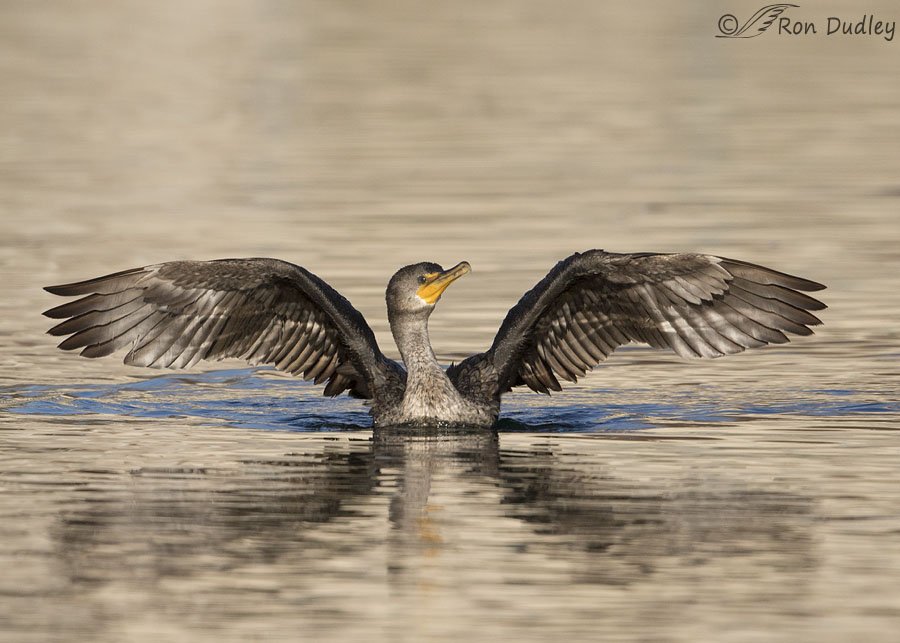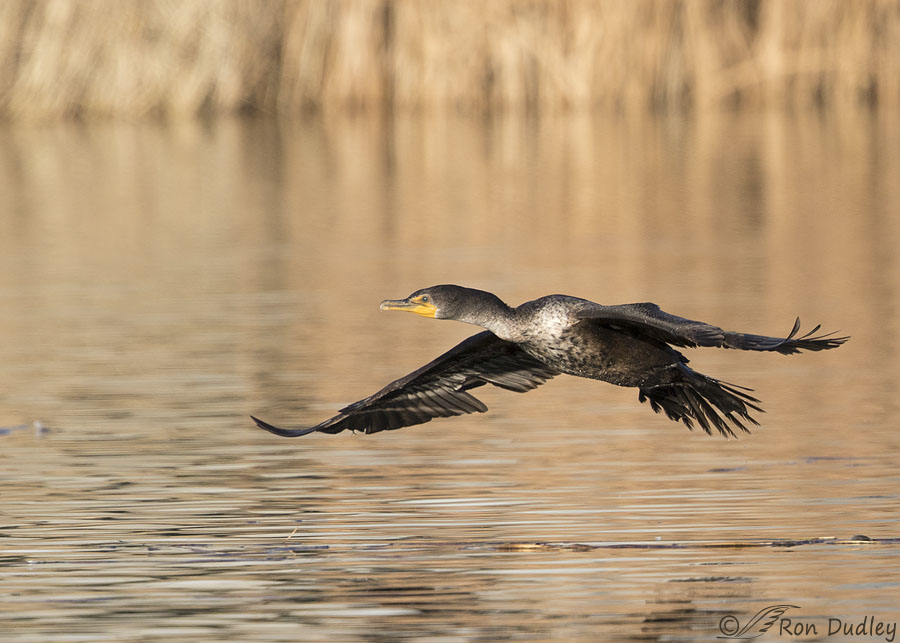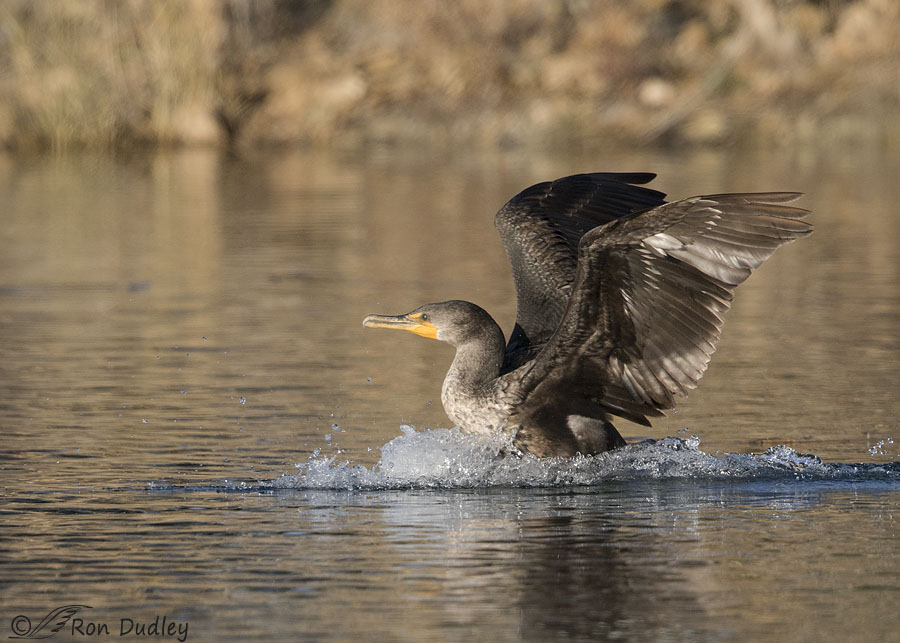Including wing-spreading, flying and landing on water.
These photos were taken 15 days ago at a local pond. Though they were all taken within a three minute time span, each one is of a different bird (I believe). All three cormorants are sub-adults.

1/5000, f/6.3, ISO 640, Canon 7D Mark II, Canon EF 500mm f/4L IS II USM + EF 1.4 III Extender, not baited, set up or called in
Wing-spreading is the classic pose of the species. It’s commonly thought that the primary reason they do it is to dry their wettable wings but there’s been abundant speculation in scientific circles about other reasons for the behavior. After all, not all cormorant species perform wing-spreading and there is no evidence that wet wings interfere with their flight.
But that’s a subject for another post.

1/2500, f/6.3, ISO 640, Canon 7D Mark II, Canon EF 500mm f/4L IS II USM + EF 1.4 III Extender, not baited, set up or called in
Very shortly after I photographed the previous bird I caught this one in flight as it came in to land on the water. I’ve often wondered what kinds of adjustments birds must make during flight when they have so many flight feathers missing, as in this bird’s right wing.
1/3200, f/6.3, ISO 640, Canon 7D Mark II, Canon EF 500mm f/4L IS II USM + EF 1.4 III Extender, not baited, set up or called in
And soon after that I captured this one as it was about to settle into the water after touchdown.
The increasing abundance of Double-crested Cormorants and the real and perceived conflicts for resources (fish primarily) between cormorants and humans have resulted in major changes in federal law regarding their management and control. Among other methods now allowed to control their numbers are egg-oiling (used to prevent hatching of their offspring} and culling (killing) of cormorants by tribal, state and federal authorities.
Yes, it’s controversial. Very.
Ron



Beautiful shots.. Yes the ugly head of “lets manage wildlife”. When will we manage human life to protect our wild neighbors?
Yes, it is amazing how the cormorant can compensate for the missing feathers. The damaged wing would try to stall at low speed. During WW II my late uncle successfully crash-landed his B-25 bomber with part of the wing and tail missing. He said he had to use variable power between the two engines to steer.
Ron, beautiful photos. I agree with Dick Harlow in that we need to learn to share this planet….well said.
Thank you, Ron
We really are an incredibly greedy species. It is all about us (and for us). Hiss and spit.
How that bird flew (let alone landed) with that missing chunk of feathers is amazing.
EC, seems to me it’s pretty unusual to have that many feathers missing on the same wing at the same place at the same time. Wonder what was going on…
I keep imagining the first Cormorant saying, “Ta daaaaa!” The second bird’s tail is looking pretty scraggly too — amazing that they can still maneuver in that condition.
The second bird’s tail is looking pretty scraggly too — amazing that they can still maneuver in that condition.
How is the snow? We’re supposed to get some rain in the next couple of days; my body agrees with the forecasters right now.
Marty, we got about 5″ of snow where I live but it was pretty localized and folks up north didn’t get much or any at all. That includes most of the places I go shooting. Cold this morning though, 17 degrees when I got up.
Lovely photos as usual. Cormorants are one of my favorites. It makes me sad to think that people are messin’ with them. Jeez… makes me wanna get up on my soapbox!
Nothing wrong with an appropriate soapbox, Joanne. Thanks.
We have arahingas in Louisiana. I think they are a type of cormorant. They eat so much the herons and other birds are going wanting. I know they are considered a nuisance where I’m from. We call them water turkeys. I’m not educated on them do this is just what I’ve been told.
Arwen, anhingas and cormorants are in distinct families though they are related.
Thank you for another lovely series of photos, Ron. Your last paragraph about the major changes in federal law regarding the management and control of cormorants is deeply disturbing. These birds are not English Starlings or feral pigeons.
“These birds are not English Starlings or feral pigeons”
Good point, Melanie!
Wonderful series Ron!
Charlotte
Thanks, Charlotte.
Nice! The first photo almost looks like a vulture sunning itself in the morning…….;) Guessing the bird had to make some adjustments for the missing feathers! Yes, human vs. “our” resources is an issue – probably aware of the Elk hunters having a fit over the wolves controlling their numbers tho they certainly aren’t an endangered species! Lazy ba…… in my opinion…….
Thanks, Judy. Yes, that elk controversy is illogical.
Oh no – here we go again. Will we ever learn when humans try to “fix” things??? We have both Anhingas & Double-crested Cormorants at Green Cay Wet lands & I have many photos of them especially when drying their wings. It’s kind of like the White Ibis & Great White Egrets – I just love photographing them!! I hadn’t heard of the possible additional reasons for drying their wings!! What are your personal thoughts, Ron? Oh I also love all three photos 2,3 & then 1 in that order for what I like the best.
“Will we ever learn when humans try to “fix” things???”
Nope, I don’t believe we ever will, Jo Ann. And that’s tragic.
As for my “personal thoughts”, in this case I won’t presume to know any more than the “experts” and they’re uncertain.
Three cormorants/three conundrums: the wing spreading, the notched wing, and the forward water disturbance while “landing”. The morning’s just begun and already my head is spinning.
It’s gonna be a long day, Lyle!
Very good photos Ron. Love those guys and gals. We have them in abundance here.
Everett Sanborn, Prescott AZ
Thanks, Everett. Yes, they’re abundant and widespread.
Wonderful shots!!
Yup, Competition! We NEED wildlife, both literally and spiritually, but compete for OUR resources, its another story another narrative!
Nope, not getting into one of my pet peeves! Just sayen we need share this planet and find ways to do so.
Agreed, Dick. Thank you.
Such a strange looking bird…but those blue eyes make up for it. If one is lucky enough to get a photo from the back and the light is just right their feather pattern is quite striking. The first time I ever photographed one I had watched a small flock standing with wings spread out for quite a while. One in particular was on one leg and it was like that for so long I actually thought it only had the one leg!
Yes, light angle can make so much difference in photos of them.
As you mention their turquoise eyes are quite striking. One day I’d like to get a photo of one highlighting their eye color to match the blue lining of their mouth and throat (requiring an open bill with appropriate light angle of course).
Now that would be a photo for the ages !!! I’ve only ever caught a slight glimpse of that mouth in a flash but never with the camera! Really didn’t know what I saw until I read up on it. I’ll be waiting!
I’ve only ever caught a slight glimpse of that mouth in a flash but never with the camera! Really didn’t know what I saw until I read up on it. I’ll be waiting! 
I’ll try but don’t hold your breath…